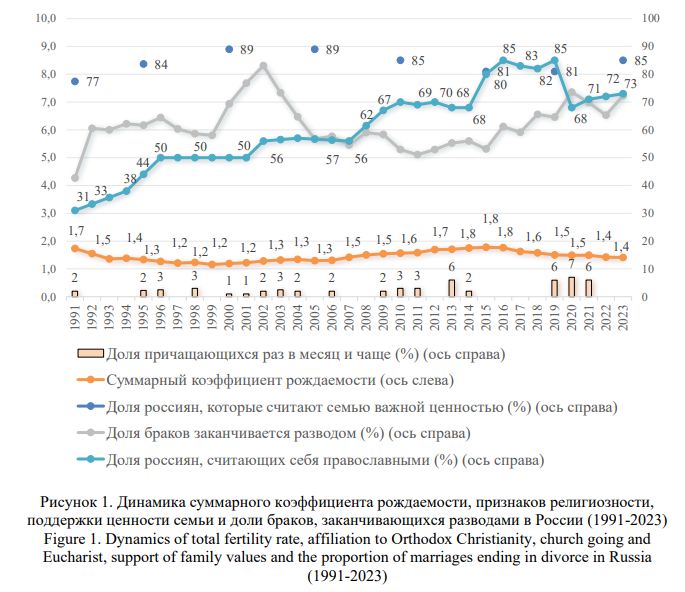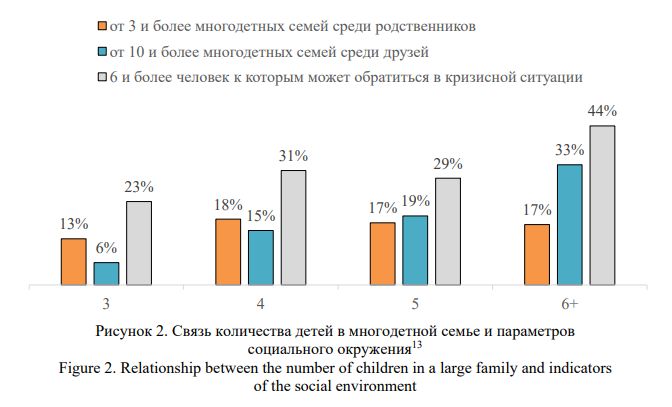Social mechanisms of transmission of family life culture through a religious network (case study of Russian Orthodox Christianity)
In the social sciences, religion is determined as an institution that traditionally favors the family. More religious societies generally have higher birth rates and more stable marriages, which means that the high value of the family is consistent with certain actions in the interests of the family. At the same time, secularization processes lead to a weakening of the coupling between family and religion, which affects the connection of values and practices in family life. However, the case of contemporary Russia shows an exception to this general rule. In the last 30 years, one can observe a consistent more than twofold increase in the proportion of the population affiliated with the Russian Orthodox Church, as well as the declared value of the family, according to various surveys. Nonetheless, there are no changes adequate to this growth in the ratio of marriages and divorces, as well as in the birth rate. To explain this gap between values and actions, we introduce the concept of family life culture, which in social sciences is close in meaning to the concepts of habitus and ethos. It includes certain value patterns, action patterns, and competencies that reduce fears, uncertainties, and conflicts in common life at the stages of family transitions. The detraditionalization of the family as a consequence of secularization processes in this sense means not just a decline in the value of the family, but an interruption of the processes of transferring the culture of family life, which leads to marriage failures and low fertility. Relying on the results of several studies on the life transition of families with many children, the relationship between the social dimension of religiosity and attitudes towards the birth of children and the stability of marriages, we formulate the hypothesis of the importance of uniting and binding social capital as social mechanisms that ensure the introduction of young families to the culture of family life is substantiated. In this sense, the dynamics of the relationship between religion and family depends on the compression or expansion of those social structures (schools, clubs, camps, etc.) that provide communication between church parish group, as bearers of a culture of family life with several children and groups that identify themselves as Orthodox, declare family values, but are weakly religious.
Figures


Pavlyutkin, I. V. (2024), “The social mechanisms of transmission of family life culture through a religious network (case study of Russian Orthodox Christianity)”, Research Result. Sociology and Management, 10 (4), 31-49. DOI: 10.18413/2408-9338-2024-10-4-0-2


















While nobody left any comments to this publication.
You can be first.
Alekseeva, P. A. (2023), “The connection between religiosity and value-normative ideas about marriage: the view of Russian married youth”, Mir Rossii, 32 (3), 119-144. (In Russian)
Artamonova, A. V., Mitrofanova, E. S. (2018), “Matrimonial behavior of Russians against the background of other Europeans”, Demographic review, 5 (1), 106-137. (In Russian)
Artamonova, A. V. (2018), “Trajectories of the formation of the Russian family: changes and factors determining them”, Sociologicheskij zhurnal, (2), 110-134. (In Russian)
Borisova, O. N., Pavlyutkin, I. V. (2019), “Variability of models of modern urban large families: revival of tradition, new marriages or network effects?”, Mir Rossii. Sociologija. Jetnologija, 28 (4), 128-151. (In Russian)
Vrublevskaya, P. V. (2016), “Сirculation of children' items in Christian Orthodox Parish: Observations to the gift exchange theory”, Researches in Religious Studies, 1 (13), 103-27. (In Russian)
Emelyanov, N. N. (2018), “The paradox of religiosity: where do believers come from?”, Monitoring obshhestvennogo mnenija: Jekonomicheskie i social'nye peremeny, (2), 32-48. (In Russian)
Emelyanov, N. N. (2019), “The importance of the family of an Orthodox priest in pastoral ministry: a theological approach”, St. Tikhon’s University Review. Theology. Philosophy. Religious Studies, (82), 34-50. (In Russian)
Granovetter, M. (2009), “The strength of weak ties”, Economic sociology, 2009. 10 (4), 31-50. (In Russian).
Goleva, M. A. (2019), “Network effects of fertility: the case of large families in Russia”, Economic sociology, 20 (3), 136-163.
Goleva, M. A. (2019), “The social significance of time in a family with children (on the example of large families)”, Monitoring obshhestvennogo mnenija: Jekonomicheskie i social'nye peremeny, (3), 239-260.
Jeffries, V. (2014), “Morality of virtue and marital solidarity”, Social'naja solidarnost' i al'truizm: sociologicheskaja tradicija i sovremennye mezhdisciplinarnye issledovanija [Social solidarity and altruism: a sociological tradition and modern interdisciplinary research], Efremenko, D. V. (ed.), INION RAN, Moscow, Russia, 109-147. (In Russian)
Zabaev, I. V., Emelyanov, N. N., Pavlenko, E. S., Pavlyutkin, I. V. (2012), Sem'ja i detorozhdenie v Rossii: kategorii roditel'skogo soznanija [Family and childbearing in Russia: categories of parental consciousness], Izd-vo PSTGU, Moscow, Russia. (In Russian)
Zabaev, I. V., Kostrova, E. A. (2023), “The Russian paradox of religion and fertility. Specification of the problem and development of an explanatory hypothesis”, St. Tikhon’s University Review. Theology. Philosophy. Religious Studies, (108), 89-111. (In Russian)
Zabaev, I. V., Kostrova, E. A. (2020), “Ethos vs habitus: an ethical component in M. Weber's “Protestant Ethics””, Sociology of Power, 32 (4), 45-67. (In Russian)
Zabaev, I., Kostrova, E., Goleva, M. (2022), “Self-realization and children: the logic of using space in the narratives of Russian women”, Sociological Review, 21 (3), 127-154. (In Russian)
Zabaev, I. V., Oreshina, D. A and Prutskova, E. V. (2014), “Social Capital of the Russian Orthodox Christianity in the Early 21st Century: Applying Social Network Analysis”, Gosudarstvo, religija, cerkov' v Rossii i za rubezhom, 32 (1), 40-66. (In Russian)
Zakharov, S., Churilova, E. (2022), “Religion, religiosity and fertility in Russia. Is there a relationship?”, Gosudarstvo, religija, cerkov' v Rossii i za rubezhom, 40(4), 77-104. (In Russian)
Kalachikova, O., Kozlova, O., Arkhangelsky, V. (2022), “The religious determinant of the reproductive intentions of Russians”, Gosudarstvo, religija, cerkov' v Rossii i za rubezhom, 40 (4). 105-138. (In Russian)
Polivanova, N., Sivak, E. V., Mikhailova, Ya. (2023), Materinstvo: novye diskursy, problemy, praktiki [Motherhood: new discourses, problems, practices], in Polivanova, K. N.(ed) , Higher School of Economics, Moscow, Russia. (In Russian)
Markina, I. V. (2016), “Family relations in relational sociology by Pierpaolo Donati”, Research result. Sociology and Management, 2 (7), 70-82. (In Russian).
Pavlyutkin, I. V., Goleva, M. A., Borisova, O. N. (2021), More zhizni: Kak rozhdajutsja mnogodetnye sem'i v sovremennoj Rossii [The sea of life: How large families are born in modern Russia], Izd-vo PSTGU, Moscow, Russia. (In Russian)
Pavlyutkin, I. V. (2021), “How community arises in marriage: the logic of reciprocity in the narratives of wives from large families”, Economic sociology, 22(4), 11-34. (In Russian)
Pavlyutkin, I. V., Goleva, M. A., Melkumyan, E.B. (2020), Analiz suzhdenij o vazhnyh i realizovannyh ozhidanijah ot braka (na dannyh onlajn-oprosa, 2019) [Analysis of judgments about important and realized expectations from marriage (based on online survey data, 2019)], Scientific Laboratory “Sociology of Religion” STU, Moscow, Russia, [Online], available at: http://socrel.pstgu.ru/RU/grants/paradox (Accessed 22 September 2024). (In Russian)
Pavlyutkin, I. V., Goleva, M.A. (2020), “How families with a large number of children are created: types of life transitions of parents”, Sociological Studies, 7 (7), 106-116. (In Russian)
Pavlyutkin, I. V., Goleva, M. A. (2023), “The importance of religion in explaining the Russian Marriage Paradox: substantiation of the hypothesis of relational competencies on the example of spouses identifying themselves with Orthodoxy”, St. Tikhon’s University Review. Theology. Philosophy. Religious Studies, (106), 107-133. (In Russian)
Posternak, A. V. (2019), “Orthodox School of megapolis in the mirror of various address groups”, Ethnodialogy, 1 (57), 57-67. (In Russian)
Prutskova E. V., Pavlyutkin I. V., Borisova O. N. (2023), “The relationship of religiosity and fertility in Russia against the background of other European countries: the effect of social context”, Monitoring of public opinion: Economic and social changes, 2 (174), 103-126. (In Russian)
Pienkova, A. V. (1996), “The concept of “habitus” in Pierre Bourdieu's sociology. Social sciences and humanities”, Social'nye i gumanitarnye nauki. Otechestvennaja i zarubezhnaja literatura: referativnyj zhurnal, 11, 26-47. (In Russian)
Sinelina, Yu. Yu. (2013), “On the dynamics of religiosity of Russians and some methodological problems of its study (religious consciousness and behavior of Orthodox and Muslims)”, Sociological Studies, (10), 104-115. (In Russian)
Tyndik, A. O. (2012), “Reproductive attitudes of the population in modern Russia”, SPERO, 16, 95-112. (In Russian).
Shcherbakova, E. M. (2024), “Demographic results of the first half of 2024 in Russia (part I)”, Demoscope Weekly, 1043-10442.
[Online], available at: https://demoscope.ru/weekly/2024/010431/barom01.php (Accessed 22 September 2024). (In Russian).
Berger, P., Kellner, H. (1964), “Marriage and the construction of reality: An exercise in the microsociology of knowledge”, Diogenes. 12 (46), 1-24.
Bourdieu, P. (1996), “On the family as a realized category”, Theory, culture & society, 13(3), 19-26.
Buber‐Ennser, I., Berghammer, C. (2021), “Religiosity and the realisation of fertility intentions: A comparative study of eight European countries”, Population, space and place, 27 (6).
Burt, R. (2001), “Structural holes versus network closure as social capital”, in N. Lin, K. S. Cook, & R. S. Burt (Eds.), Social capital: Theory and research, Aldine de Gruyter, New York, 31-56.
Coleman, J. (1990), Foundations of Social Theory, Cambridge, MA.
Coleman, J. S. (1988), “Social capital in the creation of human capital”, American journal of sociology, 94, S95-S120.
Cherlin, A. J., Chase-Lansdale, P. L., & McRae, C. (1998), “Effects of parental divorce on mental health throughout the life course”, American Sociological Review, 239-249.
Dronkers, J., Härkönen, J. (2008), “The intergenerational transmission of divorce in cross-national perspective: Results from the Fertility and Family Surveys”, Population studies, 62 (3), 273-288.
Prutskova, E. V. (2021), “Social vs. Individual Centrality of Religiosity: Research in Religious and Non-Religious Settings in Russia”, Religions, 12 (15), 1-18.
Spéder, Z., Kapitány, B. (2014), “Failure to realize fertility intentions: A key aspect of the post-communist fertility transition”, Population Research and Policy Review, 33, 393-418.
Cherlin, A. J. (2004), “The deinstitutionalization of American marriage”, Journal of marriage and family, 66 (4), 848-861.
Regnerus, M. (2020), The future of Christian marriage, Oxford University Press.
Van de Kaa, D. J. (2001), “Postmodern fertility preferences: From changing value orientation to new behavior”, Population and Development Review, 27, 290-331.
Uecker, J. E., & Hill, J. P. (2014), “Religious schools, home schools, and the timing of first marriage and first birth”, Review of Religious Research, 56(2), 189-218.
The project was supported by Saint Tikhon’s Orthodox University and The Active Tradition Foundation in 2024-2025.